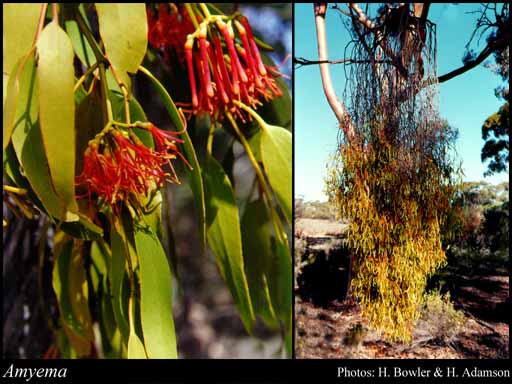- Reference
- Bull.Soc.Bot.France 506 (1895)
- Name Status
- Current







Scientific Description
Common name. Mistletoes. Family Loranthaceae.
Habit and leaf form. Shrubs; evergreen. Plants rootless (in the normal sense); partially parasitic. On aerial parts of the host. Leaves cauline (ass.). Stem internodes solid (ass.). Stem growth conspicuously sympodial. Mesophytic, or xerophytic. Leaves fasciculate (verticillate, rarely); alternate to opposite (displaced opposite, usually), or whorled (rarely); leathery, or membranous; edgewise to the stem, or with ‘normal’ orientation; simple. Leaf blades entire; flat, or solid; terete; usually curvinerved in Australian species. Leaves without stipules. Leaf blade margins entire. Leaves without a persistent basal meristem. Leaf anatomy. Extra-floral nectaries absent (ass.). Stem anatomy. Secondary thickening developing from a conventional cambial ring.
Reproductive type, pollination. Fertile flowers hermaphrodite. Unisexual flowers absent. Plants hermaphrodite. Entomophilous, or ornithophilous.
Inflorescence and flower features. Flowers aggregated in ‘inflorescences’; in heads, or in umbels. The terminal inflorescence unit cymose. Inflorescences axillary (mostly); inflorescence a pedunculate umbel made up of diads, triads or tetrads called rays, usually reduced to a single triad with the central flower sessile and the lateral flowers pedicellate; rays of umbel 2 to several, usually strongly divergent. Flowers pedicellate, or sessile; bracteate (free, usually 1 under each flower, much shorter than the flowers, concave); ebracteolate (ass.); regular; cyclic; tetracyclic. Floral receptacle markedly hollowed. Free hypanthium present; adnate to the ovary. Perianth with distinct calyx and corolla, or petaline, or absent; 3–9; 2 -whorled, or 1 -whorled. Calyx present (KPCB), or vestigial (A), or absent (apparently); 1 -whorled; gamosepalous (reduced to a lobed or toothed cup or rim); entire, or lobed; when not entire, lobulate, or blunt-lobed, or toothed; open in bud; regular; persistent. Corolla present, or absent (apparently); 4–7; 1 -whorled; polypetalous, or gamopetalous; valvate; tubular, or urceolate (elongated); unequal but not bilabiate, or bilabiate, or regular; yellow, or red. Androecial members definite in number. Androecium 4–7. Androecial members adnate (to the corolla); all equal (ass.); free of one another; 1 -whorled. Androecium exclusively of fertile stamens. Stamens 4–7; all more or less similar in shape (ass.); isomerous with the perianth; alternisepalous (epipetalous). Anthers basifixed; non-versatile; dehiscing via longitudinal slits; introrse; unilocular (KP), or bilocular (AKP), or many locular (A); bisporangiate, or tetrasporangiate. Gynoecium 3 carpelled, or 4 carpelled. The pistil 1 celled. Gynoecium syncarpous; synstylovarious, or eu-syncarpous; inferior. Ovary unilocular; 1 locular. Gynoecium stylate. Styles 1; apical. Stigmas 1. Ovules not differentiated; in the single cavity 4–12; several; sessile; ascending; non-arillate; not clearly differentiated from the placenta.
Fruit and seed features. Fruit fleshy; indehiscent; a berry, or a drupe; 1 celled (ass.); 1 seeded. Seeds copiously endospermic. Endosperm oily. Seeds covered with viscous material; without a testa. Embryo well differentiated. Cotyledons 2, or 1.
Etymology. From the Greek for "without" and "to instruct"; because the full description of the genus had not been published when the name was first used.
Taxonomic Literature
- Wheeler, Judy; Marchant, Neville; Lewington, Margaret; Graham, Lorraine 2002. Flora of the south west, Bunbury, Augusta, Denmark. Volume 2, dicotyledons. Australian Biological Resources Study.. Canberra..
- Barlow, B. A. 1992. Conspectus of the genus Amyema Tieghem (Loranthaceae).
- Blackall, William E.; Grieve, Brian J. 1988. How to know Western Australian wildflowers : a key to the flora of the extratropical regions of Western Australia. Part I : Dicotyledons (Casuarinaceae to Chenopodiaceae). University of W.A. Press.. [Perth]..
- Marchant, N. G.; Wheeler, J. R.; Rye, B. L.; Bennett, E. M.; Lander, N. S.; Macfarlane, T. D.; Western Australian Herbarium 1987. Flora of the Perth region. Part one. Western Australian Herbarium.. [Perth]..